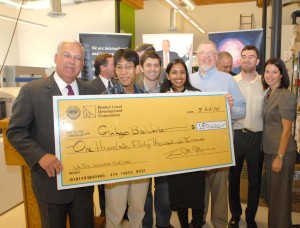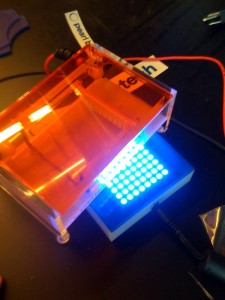I had missed this but Sri pointed it out to me. A sacred, 800+ year old Ginkgo tree fell in Japan in March due to a storm. The tree was so revered that 20,000 people from all over Japan came to pay their respects to the fallen tree. To ensure that the tree’s spirit lives on, scientists are going to try and clone the tree, under orders from the local government.
Category: From the Archives
Ginkgo in Geekville
Just a quick pointer to an op-ed in the Globe. Apparently Mayor Menino is interested in transforming Boston’s Seaport District, which Ginkgo calls home, into an innovation zone where young scientists and engineers can live and work, on the cheap.
But Menino may be on to something by promoting the waterfront to young scientists and programmers who are more invested in the construction of DNA strands than in water views and high ceilings.
Mayor Menino, you got my vote! 🙂
Biotech Lab on the Cheap
A few weeks ago, the Globe ran a story on High Tech’s Hand Me Downs. At Ginkgo, we’ve been pretty creative about putting together our lab. Ebay, labs closing up, labs moving, companies shutting down, Dovebid … we’ve tried it all for lab equipment & supplies. So here’s a few tips for those who might come after us.
Tip #1: The best deals are direct. When a company shuts down, it may elect to sell all its equipment to a lab equipment reseller but some choose to auction the equipment off themselves. Most biotech companies aren’t that old and they bought their equipment new, so most of the equipment works and is in good shape. These purchases tend to be a win-win. The company can often sell to you for more than they could a reseller, and you can often get the equipment for less than you would at a reseller.
Tip #2: BE NICE. Companies usually keep one or two employees on to handle the equipment sales after the company has gone under. This person, and all their colleagues, just lost their jobs and now he/she has to work long hours to sell off the lab in an orderly fashion. Being obnoxious just makes their lives harder and isn’t going to make them any more willing to give you a great deal.
Tip #3: You win some, you lose some. Be prepared to buy a few duds. Buying used equipment is always a bit of a gamble. That robot may not work perfectly right. Or something might break in the move. But overall you’ll generally come out ahead: buying three PCR machines for $800 each when only one of them works is still better than buying one new.
Tip #4: Some stuff you just can’t get used. Some equipment has really high resale value or has only been on the market for a short time, so used ones are scarce. The Nanodrop is an great example. It can be pretty hard to find a Nanodrop used, and if you do … it will usually go for a pretty high price. In these cases, it is often worth pricing out a new one. Some manufacturers offer startup/academic discounts which can make new equipment competitive with hard-to-find used items.
Tip #5: Always get the software and dongle! Many pieces of lab equipment require proprietary software or a dongle for operation. If the equipment doesn’t come with the software or dongle, think twice before buying. Oftentimes manufacturers don’t even sell software for older models anymore, and if they do, it can easily run you $2-5k. So that great deal stops looking so great when you factor in these added costs.
That’s it for now. Happy hunting!
Grad School Bound Bio-Engineers Wanted
As we previously announced, Ginkgo is looking for new bio-engineers to join the team as either interns or full-time employees. I thought I’d give a special call-out to college seniors who are applying to grad school right now and planning to start next fall.
Everyone here at Ginkgo had a great time in grad school. We were lucky enough to discover the coolest, emerging engineering discipline around and work in an amazing community of folks – the synth bio working group at MIT/Harvard. But grad school is a big commitment: 5-6 years of a prime time of your life. So it is important to choose the right school – and even more importantly the right lab and project – so that you get the most out of the grad school experience.
That’s why we’ve decided to offer 1 year internships to college seniors. A little-known fact is that, once you’ve been accepted to grad school, most graduate schools will let you defer for a year before joining. So if you’re headed to grad school but interested in experiencing the Ginkgo approach to synthetic biology before starting, please let us know.
[Note: College seniors can still apply for summer internships. And you don’t have to be heading to grad school to apply for the 1 year internships.]
I’ll wrap up with two key pieces of advice to grad school-bound folks. 1) Think hard about the type of PI that will work best with you. Young PIs tend to have more time for you but are necessarily focused on making a name for themselves and getting tenure. They often will tend to oversee your work more tightly which is great for preventing you from going off-track but can be bad for letting you explore your own ideas. Older PIs tend to be much busier so it is harder to talk to them about day to day experimental details, but they also tend to be more adept at mentoring different kinds of students and have more flexibility to let you run with projects. 2) Be sure and talk to as many students/post-docs/technicians in the lab as you can (without the PI present of course). You want a good sense of the lab’s strengths and weaknesses before joining and most people will give it to you straight.
Hidden Gems of iGEM
The 2009 iGEM Jamboree just wrapped up at MIT yesterday. For a summary of the results, check out 2009.igem.org. Rob Carlson also has a few posts at synthesis.cc. I thought I’d mention some of the cool work that didn’t make it into any of the awards that folks here at Ginkgo saw. (Too much good stuff happening at iGEM!)
Some of the simplest and most interesting work work in human practices was from Peking University in Beijing, China. The team was interested in DIY biology and how easy it is for amateurs and hobbyists to obtain those supplies. They ordered a variety of typical molecular biology supplies like restriction enzymes and DNA purification kits to their homes from companies around China to see which would fulfill an order to a residential address. For an anonymized summary of their results, check out their wiki page. Their human practices study was straightforward, timely and very interesting.
A second impressive project was from the U.C. Berkeley wetlab team which made a whopping 800 basic and composite standard biological parts by automating the process of part fabrication and assembly. (I believe there was a snafu in shipping so their parts aren’t listed as sent in the Registry yet.) Berkeley’s work represents a ~4-fold increase in the number of parts that other teams have contributed. With that kind of part making and assembly capability, teams can feasibly prototype working multi-component engineered biological systems in a summer. It really represents a step-change in what a team can do.
Finally, there was of course the Lego liquid handling robot from 11-year old child prodigy Gabriel See at the University of Washington. Sadly Gabriel got sick and couldn’t make it to the Jamboree but sent a cool video of him demo’ing his robot instead.
Mayor Menino visits Ginkgo

Mayor Menino visited Ginkgo today to formally announce our move to Boston and present us with a $150,000 check from the Lifetech Boston loan program for early stage startups. Barry gave him a tour around our new digs and even showed him a demo of one of our Ginkgo-bots.
You can check out coverage by the Boston Herald and the Mass High Tech.
We’d like to give a shout-out to all those who made our move to Boston possible – in particular Martina Toponarski from Lifetech Boston, Bill Nickerson from the BLDC, Mayor Menino, and Ginkgo’s landlord Paul Mustone from Reflex Lighting.
Update: See also Emily Singer’s Technology Review article and Mayor Menino’s Wicked Local column.
Ginkgo becoming popular destination for top cruise ships

The Crystal Symphony (Conde Nast Traveler’s #2 cruise ship in the world, 2006) docked next to Ginkgo yesterday and pretty much fills our skyline. We welcome its 922 guests and 545 crew.
Join the Revolution
Just a quick post to spread the word that Ginkgo is looking for kick ass engineers, scientists and hackers to join the team. More info at the website.
Looking for a detailed job description or required qualifications? Sorry but this is Ginkgo, not your typical biotech. We’re looking for people interested in doing it all and laying the foundations for building any engineered biological system we can dream up.
We have big dreams. If you do too, come talk to us.
Pearl Biotech Open Gel (Un)Box(ing)

Just received our gel box in the mail today. Pearl has added a great tweak to the standard gel box with an illuminator that fits snuggly under the box. The illuminator apparently does a good job of exciting SYBR Safe DNA stain so you can watch your DNA running in real time. The design is open sourced and it would be great to see someone design a camera mount for the gel box to make a cheap gel imager. All in all, the box looks solidly built and it’s exciting to see people innovating on tools for biological engineering. Looking forward to seeing more from Pearl in the future.
From the Archives: Root Bridges
Some Synthetic Biologists aspire to live in a house grown from a reprogrammed tree. We’re not there yet but our ability to train trees to form useful structures certainly gives cause for optimism. Take for example the living root bridges of the War-Khasis tribe in Northeastern India. Strong, flexible roots are trained to grow across rivers and take root on the far side. While a bridge can take 10 years to grow some may be more than 500 years old and still getting stronger. Much like good whiskey, these root bridges take a long time to make, but once made, they get better and better.

Image source – Vanlal.
